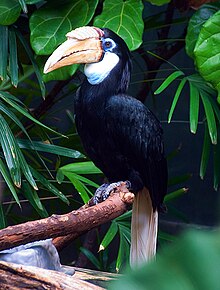Blyth's hornbill
| Blyth's hornbill | |
|---|---|

| |
| Adult male at Lincoln Park Zoo | |

| |
| Female | |
| Scientific classification | |
| Domain: | Eukaryota |
| Kingdom: | Animalia |
| Phylum: | Chordata |
| Class: | Aves |
| Order: | Bucerotiformes |
| Family: | Bucerotidae |
| Genus: | Rhyticeros |
| Species: | R. plicatus
|
| Binomial name | |
| Rhyticeros plicatus (Pennant, 1781)
| |
| Subspecies | |
|
6 subspecies, see text | |
| Synonyms | |
|
Aceros plicatus (Forster, 1781) | |
Blyth's hornbill (Rhyticeros plicatus), also known as the Papuan hornbill, is a large
Previously, this hornbill was placed in the
The common name commemorates
Description

Up to 91 cm (36 in) in length, the adult male has mainly black plumage with a golden or orange-buff head, white throat and a white tail. Its irises are reddish brown, and the eye is surrounded by naked pale blue skin. The female is a smaller, mainly black bird with a white throat and tail. Both sexes have a very large horn-coloured bill and casque. Young birds of both sexes resemble the male. Adults have up to eight folds on the pale casque, depending on age, while young birds have none.[5]
In flight the sound of its wings is loud and distinctive, a rushing noise that has been compared to the sound of steam escaping from a steam locomotive. It has a range of far-reaching, guttural grunting and laughing calls.[5]
Subspecies
Various subspecies have been described across its range:[6]
- R. p. plicatus (Forster, 1781) – South Moluccas
- R. p. ruficollis (Vieillot, 1816) – Simbu Province, Papua New Guinea
- R. p. jungei Mayr, 1937 – Eastern New Guinea, west as far as the Fly River region
- R. p. dampieri Mayr, 1934 – Bismarck Archipelago
- R. p. harterti Mayr, 1934 – Bougainville and Buka Islands
- R. p. mendanae Hartert, 1924 – Solomon Islands from Choiseul to Guadalcanal and Malaita
Distribution and ecology
The Papuan hornbill occurs throughout lowland forests, from sea level up to 1,200–1,500 m
Its diet consists mainly of fruits, especially figs, occasionally supplemented with insects and other small animals.[5]
The Papuan hornbill nests in a large tree hollow in the rainforest, from at least 18 m (59 ft) up to 30 m (98 ft) above the ground. The female is restricted to the nest cavity throughout the incubation and nestling period, being largely sealed inside by plastering up the entrance with a mixture of fruit pulp and rotten wood, leaving only a narrow aperture through which the male feeds her. The clutch size is about two eggs.[9]
Status and relationship with humans
Still widespread throughout its large range, the Papuan hornbill is assessed as
References
- . Retrieved 12 November 2021.
- ^ "Appendices | CITES". cites.org. Retrieved 2022-01-14.
- ^ Majnep & Bulmer (1977): p.129, Coates (1985), Coates & Bishop (1997)
- ^ Rasmussen (2000)
- ^ a b c Coates (1985): p.442
- ^ Coates (1985): p.444, Coates & Bishop (1997): p.148, Steadman (2006): pp.123,153,366-367
- ^ Coates (1985), Coates & Bishop (1997)
- ^ "Canberra Bird Notes" (PDF). CANBERRA ORNITHOLOGISTS GROUP, INC. Retrieved 3 March 2023.
- ^ Coates (1985): p.444
- ^ BLI (2008)
- ^ Majnep & Bulmer (1977): p.129, Coates (1985): pp.442,444, Steadman (2006): pp.366-367
- Coates, Brian J. (1985): The Birds of Papua New Guinea (Vol.1: Non-Passerines). Dove Publications, Alderley, Queensland, Australia. ISBN 0-9590257-0-7
- Coates, Brian J. & Bishop, K. David (1997): A Guide to the Birds of Wallacea, Sulawesi, the Moluccas and Lesser Sunda Islands, Indonesia. Dove Publications, Alderley, Queensland, Australia. ISBN 0-9590257-3-1
- Majnep, Ian Saem & Bulmer, Ralph (1977): Birds of my Kalam Country. Auckland University Press, Auckland, New Zealand.
- Rasmussen, Pamela C. (August 2000). "A review of the taxonomy and status of the Plain-pouched Hornbill Aceros subruficollis" (PDF). Forktail. 16: 83–86. Retrieved 4 October 2015.
- ISBN 0-226-77142-3

